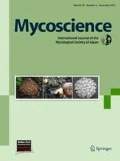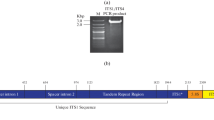Abstract
The mitochondrial rps3 gene in some filamentous ascomycetes fungi is encoded within an rnl group I intron. In Grosmannia piceiperda the N-terminal segment of the intron-encoded rps3 gene has been invaded by an IC2-type group I intron. This intron disrupts the recipient rps3 and fragments this gene into two open reading frames (ORFs). The IC2 group I intron encodes a putative double-motif LAGLIDADG ORF, which is fused in-frame to the upstream rps3 exon sequence. The presence of the LAGLIDADG amino acid motif is indicative of an enzyme that has endonuclease and/or maturase activity and thus the intron encoded protein could be involved in promoting splicing and mobility. Reverse transcriptase polymerase chain reaction (RT-PCR) confirmed that this intron is spliced in vivo and as a result this could allow for the expression of a functional ribosomal Rps3 protein.


Similar content being viewed by others
References
Belfort M, Derbyshire V, Cousineau B, Lambowitz A (2002) Mobile introns: pathways and proteins. In: Craig N, Craigie R, Gellert M, Lambowitz A (eds) Mobile DNA II. ASM Press, Washington, DC, pp 761–783
Bell JA, Monteiro-Vitorello CB, Hausner G, Fulbright DW, Bertrand H (1996) Physical and genetic map of the mitochondrial genome of Cryphonectria parasitica Ep155. Curr Genet 30:34–43
Burke JM, RajBhandary UL (1982) Intron within the large rRNA gene of N. crassa mitochondria: a long open reading frame and a consensus sequence possibly important in splicing. Cell 31:509–520
Caprara MG, Waring RB (2005) Group I introns and their maturases: uninvited, but welcome guests. Nucleic Acids Mol Biol 16:103–119
Cech TR, Damberger SH, Gutell ER (1994) Representation of the secondary and tertiary structure of group I introns. Nat Struct Biol 1:273–280
Grivell LA (1995) Nucleo-mitochondrial interactions in mitochondrial gene expression. Crit Rev Biochem Mol Biol 30:121–164
Hausner G (2012) Introns, mobile elements and plasmids. In: Bullerwell CE (ed) Organelle genetics: evolution of organelle genomes and gene expression. Springer, Berlin, pp 329–358
Johansen JS, Haugen P (2001) A new nomenclature of group I introns in ribosomal DNA. RNA 7:935–936
Lang BF, Laforest MJ, Burger G (2007) Mitochondrial introns: a critical view. Trends Genet 23:119–125
Michel F, Westhof E (1990) Modeling of the three-dimensional architecture of group I catalytic introns based on comparative sequence analysis. J Mol Biol 216:585–610
Mota EM, Collins RA (1988) Independent evolution of structural and coding regions in a Neurospora mitochondrial intron. Nature 332:654–656
Nicholas KB, Nicholas HB Jr, Deerfield DW (1997) GeneDoc: analysis and visualization of genetic variation. EMB News 4:14
Sellem CH, Belcour L (1997) Intron open reading frames as mobile elements and evolution of a group I intron. Mol Biol Evol 14:518–526
Sethuraman J, Majer A, Friedrich N, Edgell D, Hausner G (2009a) Genes-within-genes: multiple LAGLIDADG homing endonucleases target the ribosomal protein S3 gene encoded within an rnl group I intron of Ophiostoma and related taxa. Mol Biol Evol 26:2299–2315
Sethuraman J, Majer A, Iranpour M, Hausner G (2009b) Molecular evolution of the mtDNA encoded rps3 gene among filamentous ascomycetes fungi with an emphasis on the ophiostomatoid fungi. J Mol Evol 69:372–385
Stoddard BL (2006) Homing endonuclease structure and function. Q Rev Biophys 1:49–95
Takeuchi R, Lambert AR, Mak AN, Jacoby K, Dickson RJ, Gloor GB, Scharenberg AM, Edgell DR, Stoddard BL (2011) Tapping natural reservoirs of homing endonucleases for targeted gene modification. Proc Natl Acad Sci USA 108:13077–13082
Thompson JD, Gibson TJ, Plewniak F, Jeanmougin F, Higgins DG (1997) The CLUSTAL_X windows interface: flexible strategies for multiple sequence alignment aided by quality analysis tools. Nucleic Acids Res 25:4876–4882
Zuker M (2003) Mfold web server for nucleic acid folding and hybridization prediction. Nucleic Acids Res 31:3406–3415
Acknowledgments
This work is supported by a Discovery Grant from the Natural Sciences and Engineering Research Council of Canada (NSERC) to G.H.
Author information
Authors and Affiliations
Corresponding author
About this article
Cite this article
Rudski, S.M., Hausner, G. The mtDNA rps3 locus has been invaded by a group I intron in some species of Grosmannia . Mycoscience 53, 471–475 (2012). https://doi.org/10.1007/s10267-012-0183-2
Received:
Accepted:
Published:
Issue Date:
DOI: https://doi.org/10.1007/s10267-012-0183-2




